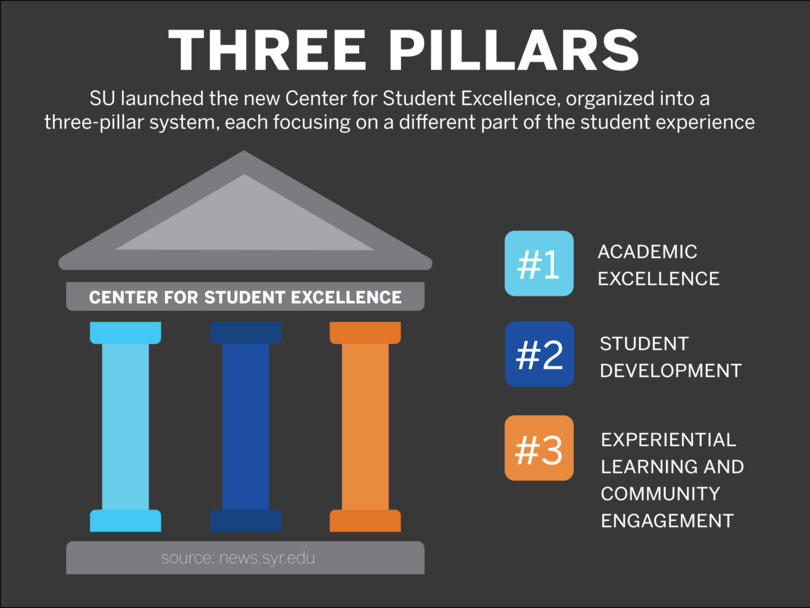Inside 3 pillar system behind SU’s new Center for Student Excellence

SU’s newly launched Center for Student Excellence intends to restructure several of its student support programs into one office. CSE will be organized into a three-pillar system, each focusing on a different part of the student experience. Katie Crews | Design Editor
Get the latest Syracuse news delivered right to your inbox.
Subscribe to our newsletter here.
After Syracuse University launched its Center for Student Excellence, merging 13 organizations under one office, students were left wondering what would happen next for their respective programs.
When the university announced the office’s Aug. 28 opening, SU said it’s bringing together several of its student support services and programs into one overarching office to “enhance student support programs.”
The office will be organized into a three-pillar system, each focusing on a different part of the “student experience.”
Angelie Serrano Báez, an SU junior and an Our Time Has Come scholar, believes the restructuring will make finding resources more difficult for students, she said in a Wednesday statement to The D.O.
She said that in theory combining the offices sounds like a good idea, but in reality, it “groups everyone together,” limiting the kinds of help and resources organizations and students have access to.
Some students need specific assistance on campus, but with the new restructuring, she said they could be pushed aside.
“I don’t think the new setup is necessarily going to better support underrepresented students,” Báez wrote. “Those programs worked best when they were more focused on the unique challenges we face, and I worry that centralizing everything is going to water that down.”
The Daily Orange has broken down each pillar, its respective programs and campus reactions.
First pillar – Academic Success
The first pillar houses First Year Seminar, the Center for Learning and Student Success, Office of Retention and Student Success and Office of Student-Athlete Success and Engagement.
First Year Seminar (FYS) is a one-credit course all freshmen and transfer students are required to take at the start of their time at SU. It’s intended to help students transition to the university, understand campus resources and “be prepared to navigate diverse perspectives” and contribute to the communities they’re a part of.
Center for Learning and Student Success (CLASS), provides students with free academic assistance, including academic coaching, weekly workshops and individual and group tutoring.
Another part of the first pillar is the Office of Retention and Student Success, which assists students through resources including advisor check-ins, an academic calendar and “personalized support and mentorship.”
The website also allows professors to proactively inform students of concerns through a “flag” or encourage them with a “kudos” through email alerts.
The Office of Student-Athlete Success and Engagement connects student-athletes with guidance and mentorship programs to assist them with balancing both academic and athletic commitments.
Second pillar – Student Development
The second pillar includes several programs focused on improving student life, including Living Learning Communities, Higher Education Opportunity Program and Student Support Services Office, the Science and Technology Entry Program, the Collegiate Science and Technology Entry Program and the McNair Scholars Program.
Living Learning Communities (LLCs) are specialized residential communities, allowing students who share a common interest, major or cultural connection to live on the same floor in dormitories.
The Higher Education Opportunity Program and Student Support Services (HEOP and SSS Office) provides assistance to students who come from underrepresented communities. Eligible students qualify for financial aid and are provided with resources including mentorship and advising programs. New York state funds HEOP, while SSS is federally funded.
The Science and Technology Entry Program (STEP) helps high school students in the city of Syracuse learn skills needed for professional degree programs in the health, technical and scientific fields. Through hands-on activities, students receive education that has “real-life implications,” according to STEP’s Facebook account.
The Collegiate Science and Technology Entry Program (CSTEP) is intended to provide underrepresented students with guidance for careers in medicine, law, healthcare, accounting and STEM and “customized strategies” for success.
The McNair Scholars Program supports high-achieving undergraduates preparing for graduate degree applications, including providing them with research stipends, weekly mentorship meetings and fee-waivers.
Before the restructuring, the Center for Academic Achievement and Student Development housed CSTEP, STEP, HEOP, SSS and the McNair Scholar program.
The CAASD website is still an active link, but all of its content has been removed.
Third pillar – Experiential Learning and Community Engagement
The third pillar of CSE comprises the Center for Fellowship and Scholarship Advising, the Shaw Center, the Syracuse Office of Undergraduate Research and Creative Engagement and Our Time Has Come scholars in order to help students engage further in their communities.
The Center for Fellowship and Scholarship Advising assists students in finding scholarships and fellowships both at SU and across the country. CFSA also participates in the administration of three “high-profile” SU scholarships including SU Scholars, Remembrance Scholars and Seinfeld Scholar Awards for Undergraduates.
The Shaw Center works with students and faculty to engage with the Syracuse city area through volunteer opportunities, including the SU Literacy Corps, which focuses on helping local schools.
Students in all academic disciplines have the opportunity through Syracuse Office of Undergraduate Research and Creative Engagement (SOURCE) to perform research as a part of their thesis, through a distinction program or independently.
SOURCE also provides research funding grants through an application process.
The Our Time Has Come (OTHC) Scholars Program, located under the Office of Multicultural Advancement, is a scholarship program for “ambitious” students guided toward helping these students expand their professional circles and leadership skills.
Campus reactions
In a statement to The D.O., Sarah Dias, an SU senior intern at the Shaw Center, said she wasn’t informed of the restructuring of these organizations beforehand.
“(I) found out through the Syracuse University News article which my supervisor shared with me,” Dias wrote. “I was a little surprised, but the Shaw Center is highly adaptable because of the amazing people who work within the office, so I know wherever the office goes it will thrive.”
Dias said the transition will potentially carry unknowns, but she hasn’t experienced any direct changes yet. However, she said the center, which has been open since 1994, will be given a new permanent location.
“I think it will take some time to adjust once this move occurs, especially for us who intern or volunteer with the Shaw Center,” she wrote.
She’s “optimistic” about CSE’s future, she wrote, but only if the resources are made easily available to students, rather than having to search for them.
In a statement to The D.O., Tommy Powell, assistant provost for academic programs, said the restructuring is a “major step” in how SU will continue to support its students.
In his statement, Powell said the university is focused on providing “continuity” to students across the board, especially with its scholarship programs and “resources vital to student success.”
“The Office of Academic Affairs has reaffirmed its commitment to these initiatives, and their integration within the new structure is expected to expand both reach and impact,” Powell wrote. “While some adjustments will be needed, the result will be a more connected, student-centered approach that benefits the entire campus.”
“We’re not just reorganizing existing resources—we’re amplifying their impact and creating new pathways for students to thrive, persist and graduate with the skills and experiences they need to be leaders and engaged citizens,” Julie Hasenwinkel, associate provost for academic programs, said in the Aug. 28 release announcing the office’s opening.
The office will be separated into three pillars, a structure that will allow the transition to occur “collaboratively,” Powell wrote. It will eliminate “duplicative services,” he said, and give students easier access to support.
“This restructuring reflects national trends in student success and the evolving needs of our own community,” Powell wrote. “The Office of Academic Affairs led the planning process, consulting widely and incorporating feedback from all offices to shape the center’s design.”
DISCLAIMER: Shivika Gupta is a Living Learning Community Residential Advisor. Her experience did not affect the editorial content of this article.






